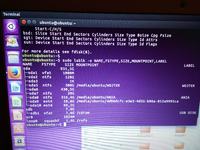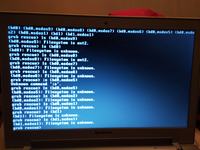Boot Info Script 0.61 [1 April 2012]
============================= Boot Info Summary: ===============================
=> Grub2 (v1.99) is installed in the MBR of /dev/sda and looks at sector 1 of
the same hard drive for core.img. core.img is at this location and looks
in partition 112 for .
=> Syslinux MBR (4.04 and higher) is installed in the MBR of /dev/sdb.
sda1: __________________________________________________________________________
File system: vfat
Boot sector type: Windows 7: FAT32
Boot sector info: No errors found in the Boot Parameter Block.
Operating System:
Boot files: /bootmgr /boot/bcd /KERNEL.SYS /COMMAND.COM
sda2: __________________________________________________________________________
File system: ntfs
Boot sector type: Windows Vista/7: NTFS
Boot sector info: No errors found in the Boot Parameter Block.
Operating System:
Boot files: /Windows/System32/winload.exe
sda3: __________________________________________________________________________
File system: Extended Partition
Boot sector type: -
Boot sector info:
sda5: __________________________________________________________________________
File system: ntfs
Boot sector type: Windows Vista/7: NTFS
Boot sector info: No errors found in the Boot Parameter Block.
Operating System:
Boot files:
sda6: __________________________________________________________________________
File system:
Boot sector type: Unknown
Boot sector info:
Mounting failed: mount: unknown filesystem type ''
sda7: __________________________________________________________________________
File system: ntfs
Boot sector type: Windows XP: NTFS
Boot sector info: According to the info in the boot sector, sda7 starts
at sector 63. According to the info in the boot
sector, sda7 has 41943039 sectors, but according to
the info from fdisk, it has 663589832 sectors.
Operating System:
Boot files:
sda8: __________________________________________________________________________
File system: ntfs
Boot sector type: Windows Vista/7: NTFS
Boot sector info: According to the info in the boot sector, sda8 starts
at sector 1092571136. But according to the info from
fdisk, sda8 starts at sector 1756162048. The info in
the boot sector on the starting sector of the MFT
Mirror is wrong. According to the info in the boot
sector, sda8 has 663589832 sectors, but according to
the info from fdisk, it has 39059455 sectors.
Operating System:
Boot files:
sda9: __________________________________________________________________________
File system: ext4
Boot sector type: -
Boot sector info:
Operating System: Linux Mint 17.2 Rafaela
Boot files: /boot/grub/grub.cfg /etc/fstab
sdb1: __________________________________________________________________________
File system: vfat
Boot sector type: SYSLINUX 6.02 2013-10-13... :..(:,:0:4:8:....D:H:L:[.T:[.\:`:d:[.l:p:t:x

:.:.:.:.:.:.:.:...........
Boot sector info: Syslinux looks at sector 2975920 of /dev/sdb1 for its
second stage. SYSLINUX is installed in the directory.
The integrity check of the ADV area failed. No errors
found in the Boot Parameter Block.
Operating System:
Boot files: /syslinux/syslinux.cfg /ldlinux.sys
/syslinux/ldlinux.sys
============================ Drive/Partition Info: =============================
Drive: sda _____________________________________________________________________
Disk /dev/sda: 931,5 GiB, 1000204886016 bytes, 1953525168 sectors
Units: sectors of 1 * 512 = 512 bytes
Sector size (logical/physical): 512 bytes / 4096 bytes
I/O size (minimum/optimal): 4096 bytes / 4096 bytes
Disklabel type: dos
Partition Boot Start Sector End Sector # of Sectors Id System
/dev/sda1 * 2,048 2,050,047 2,048,000 b W95 FAT32
/dev/sda2 2,050,048 253,708,287 251,658,240 7 NTFS / exFAT / HPFS
/dev/sda3 253,710,334 1,953,523,711 1,699,813,378 f W95 Extended (LBA)
/dev/sda5 253,710,336 1,050,623,999 796,913,664 7 NTFS / exFAT / HPFS
/dev/sda6 1,050,626,048 1,092,569,087 41,943,040 7 NTFS / exFAT / HPFS
/dev/sda7 1,092,571,136 1,756,160,968 663,589,833 7 NTFS / exFAT / HPFS
/dev/sda8 1,756,162,048 1,795,221,503 39,059,456 83 Linux
/dev/sda9 1,814,757,376 1,953,523,711 138,766,336 83 Linux
Drive: sdb _____________________________________________________________________
Disk /dev/sdb: 7,6 GiB, 8103395328 bytes, 15826944 sectors
Units: sectors of 1 * 512 = 512 bytes
Sector size (logical/physical): 512 bytes / 512 bytes
I/O size (minimum/optimal): 512 bytes / 512 bytes
Disklabel type: dos
Partition Boot Start Sector End Sector # of Sectors Id System
/dev/sdb1 * 63 15,826,943 15,826,881 c W95 FAT32 (LBA)
"blkid" output: ________________________________________________________________
Device UUID TYPE LABEL
/dev/loop0 squashfs
/dev/sda1 EE5C-6E50 vfat
/dev/sda10 a4e912ba-5bb6-41c9-b60d-72f2e1cca07a ext4
/dev/sda2 0026F18826F17F4A ntfs
/dev/sda5 6CA1EE5803960712 ntfs WOJTEK
/dev/sda6
/dev/sda7 01D24C2AC96D3300 ntfs
/dev/sda8 75D5366261DAA54F ntfs ANIA
/dev/sda9 4d06dcfc-e3e3-4d35-b96a-812a9995cae7 ext4
/dev/sdb1 92BF-2F7B vfat USB DISK
================================ Mount points: =================================
Device Mount_Point Type Options
/dev/loop0 /rofs squashfs (ro,noatime)
/dev/sdb1 /cdrom vfat (ro,noatime,fmask=0022,dmask=0022,codepage=437,iocharset=iso8859-1,shortname=mixed,errors=remount-ro)
=========================== sda9/boot/grub/grub.cfg: ===========================
--------------------------------------------------------------------------------
#
# DO NOT EDIT THIS FILE
#
# It is automatically generated by grub-mkconfig using templates
# from /etc/grub.d and settings from /etc/default/grub
#
### BEGIN /etc/grub.d/00_header ###
if [ -s $prefix/grubenv ]; then
set have_grubenv=true
load_env
fi
if [ "${next_entry}" ] ; then
set default="${next_entry}"
set next_entry=
save_env next_entry
set boot_once=true
else
set default="4"
fi
if [ x"${feature_menuentry_id}" = xy ]; then
menuentry_id_option="--id"
else
menuentry_id_option=""
fi
export menuentry_id_option
if [ "${prev_saved_entry}" ]; then
set saved_entry="${prev_saved_entry}"
save_env saved_entry
set prev_saved_entry=
save_env prev_saved_entry
set boot_once=true
fi
function savedefault {
if [ -z "${boot_once}" ]; then
saved_entry="${chosen}"
save_env saved_entry
fi
}
function recordfail {
set recordfail=1
if [ -n "${have_grubenv}" ]; then if [ -z "${boot_once}" ]; then save_env recordfail; fi; fi
}
function load_video {
if [ x$feature_all_video_module = xy ]; then
insmod all_video
else
insmod efi_gop
insmod efi_uga
insmod ieee1275_fb
insmod vbe
insmod vga
insmod video_bochs
insmod video_cirrus
fi
}
if [ x$feature_default_font_path = xy ] ; then
font=unicode
else
insmod part_msdos
insmod ext2
set root='hd0,msdos7'
if [ x$feature_platform_search_hint = xy ]; then
search --no-floppy --fs-uuid --set=root --hint-bios=hd0,msdos7 --hint-efi=hd0,msdos7 --hint-baremetal=ahci0,msdos7 4d06dcfc-e3e3-4d35-b96a-812a9995cae7
else
search --no-floppy --fs-uuid --set=root 4d06dcfc-e3e3-4d35-b96a-812a9995cae7
fi
font="/usr/share/grub/unicode.pf2"
fi
if loadfont $font ; then
set gfxmode=auto
load_video
insmod gfxterm
set locale_dir=$prefix/locale
set lang=pl_PL
insmod gettext
fi
terminal_output gfxterm
if [ "${recordfail}" = 1 ] ; then
set timeout=30
else
if [ x$feature_timeout_style = xy ] ; then
set timeout_style=menu
set timeout=10
# Fallback normal timeout code in case the timeout_style feature is
# unavailable.
else
set timeout=10
fi
fi
### END /etc/grub.d/00_header ###
### BEGIN /etc/grub.d/05_debian_theme ###
set menu_color_normal=white/black
set menu_color_highlight=black/light-gray
### END /etc/grub.d/05_debian_theme ###
### BEGIN /etc/grub.d/06_mint_theme ###
set menu_color_normal=white/black
set menu_color_highlight=white/light-gray
### END /etc/grub.d/06_mint_theme ###
### BEGIN /etc/grub.d/10_linux ###
function gfxmode {
set gfxpayload="${1}"
if [ "${1}" = "keep" ]; then
set vt_handoff=vt.handoff=7
else
set vt_handoff=
fi
}
if [ "${recordfail}" != 1 ]; then
if [ -e ${prefix}/gfxblacklist.txt ]; then
if hwmatch ${prefix}/gfxblacklist.txt 3; then
if [ ${match} = 0 ]; then
set linux_gfx_mode=keep
else
set linux_gfx_mode=text
fi
else
set linux_gfx_mode=text
fi
else
set linux_gfx_mode=keep
fi
else
set linux_gfx_mode=text
fi
export linux_gfx_mode
menuentry 'Linux Mint 17.2 MATE 64-bit' --class ubuntu --class gnu-linux --class gnu --class os $menuentry_id_option 'gnulinux-simple-4d06dcfc-e3e3-4d35-b96a-812a9995cae7' {
recordfail
load_video
gfxmode $linux_gfx_mode
insmod gzio
insmod part_msdos
insmod ext2
set root='hd0,msdos7'
if [ x$feature_platform_search_hint = xy ]; then
search --no-floppy --fs-uuid --set=root --hint-bios=hd0,msdos7 --hint-efi=hd0,msdos7 --hint-baremetal=ahci0,msdos7 4d06dcfc-e3e3-4d35-b96a-812a9995cae7
else
search --no-floppy --fs-uuid --set=root 4d06dcfc-e3e3-4d35-b96a-812a9995cae7
fi
linux /boot/vmlinuz-3.16.0-38-generic root=UUID=4d06dcfc-e3e3-4d35-b96a-812a9995cae7 ro quiet splash $vt_handoff
initrd /boot/initrd.img-3.16.0-38-generic
}
submenu 'Advanced options for Linux Mint 17.2 MATE 64-bit' $menuentry_id_option 'gnulinux-advanced-4d06dcfc-e3e3-4d35-b96a-812a9995cae7' {
menuentry 'Linux Mint 17.2 MATE 64-bit, with Linux 3.16.0-38-generic' --class ubuntu --class gnu-linux --class gnu --class os $menuentry_id_option 'gnulinux-3.16.0-38-generic-advanced-4d06dcfc-e3e3-4d35-b96a-812a9995cae7' {
recordfail
load_video
gfxmode $linux_gfx_mode
insmod gzio
insmod part_msdos
insmod ext2
set root='hd0,msdos7'
if [ x$feature_platform_search_hint = xy ]; then
search --no-floppy --fs-uuid --set=root --hint-bios=hd0,msdos7 --hint-efi=hd0,msdos7 --hint-baremetal=ahci0,msdos7 4d06dcfc-e3e3-4d35-b96a-812a9995cae7
else
search --no-floppy --fs-uuid --set=root 4d06dcfc-e3e3-4d35-b96a-812a9995cae7
fi
echo 'Loading Linux 3.16.0-38-generic ...'
linux /boot/vmlinuz-3.16.0-38-generic root=UUID=4d06dcfc-e3e3-4d35-b96a-812a9995cae7 ro quiet splash $vt_handoff
echo 'Loading initial ramdisk ...'
initrd /boot/initrd.img-3.16.0-38-generic
}
menuentry 'Linux Mint 17.2 MATE 64-bit, with Linux 3.16.0-38-generic (recovery mode)' --class ubuntu --class gnu-linux --class gnu --class os $menuentry_id_option 'gnulinux-3.16.0-38-generic-recovery-4d06dcfc-e3e3-4d35-b96a-812a9995cae7' {
recordfail
load_video
insmod gzio
insmod part_msdos
insmod ext2
set root='hd0,msdos7'
if [ x$feature_platform_search_hint = xy ]; then
search --no-floppy --fs-uuid --set=root --hint-bios=hd0,msdos7 --hint-efi=hd0,msdos7 --hint-baremetal=ahci0,msdos7 4d06dcfc-e3e3-4d35-b96a-812a9995cae7
else
search --no-floppy --fs-uuid --set=root 4d06dcfc-e3e3-4d35-b96a-812a9995cae7
fi
echo 'Loading Linux 3.16.0-38-generic ...'
linux /boot/vmlinuz-3.16.0-38-generic root=UUID=4d06dcfc-e3e3-4d35-b96a-812a9995cae7 ro recovery nomodeset
echo 'Loading initial ramdisk ...'
initrd /boot/initrd.img-3.16.0-38-generic
}
}
### END /etc/grub.d/10_linux ###
### BEGIN /etc/grub.d/10_lupin ###
### END /etc/grub.d/10_lupin ###
### BEGIN /etc/grub.d/20_linux_xen ###
### END /etc/grub.d/20_linux_xen ###
### BEGIN /etc/grub.d/20_memtest86+ ###
menuentry 'Memory test (memtest86+)' {
insmod part_msdos
insmod ext2
set root='hd0,msdos7'
if [ x$feature_platform_search_hint = xy ]; then
search --no-floppy --fs-uuid --set=root --hint-bios=hd0,msdos7 --hint-efi=hd0,msdos7 --hint-baremetal=ahci0,msdos7 4d06dcfc-e3e3-4d35-b96a-812a9995cae7
else
search --no-floppy --fs-uuid --set=root 4d06dcfc-e3e3-4d35-b96a-812a9995cae7
fi
knetbsd /boot/memtest86+.elf
}
menuentry 'Memory test (memtest86+, serial console 115200)' {
insmod part_msdos
insmod ext2
set root='hd0,msdos7'
if [ x$feature_platform_search_hint = xy ]; then
search --no-floppy --fs-uuid --set=root --hint-bios=hd0,msdos7 --hint-efi=hd0,msdos7 --hint-baremetal=ahci0,msdos7 4d06dcfc-e3e3-4d35-b96a-812a9995cae7
else
search --no-floppy --fs-uuid --set=root 4d06dcfc-e3e3-4d35-b96a-812a9995cae7
fi
linux16 /boot/memtest86+.bin console=ttyS0,115200n8
}
### END /etc/grub.d/20_memtest86+ ###
### BEGIN /etc/grub.d/30_os-prober ###
menuentry 'Windows 7 (on /dev/sda1)' --class windows --class os $menuentry_id_option 'osprober-chain-EE5C-6E50' {
insmod part_msdos
insmod fat
set root='hd0,msdos1'
if [ x$feature_platform_search_hint = xy ]; then
search --no-floppy --fs-uuid --set=root --hint-bios=hd0,msdos1 --hint-efi=hd0,msdos1 --hint-baremetal=ahci0,msdos1 EE5C-6E50
else
search --no-floppy --fs-uuid --set=root EE5C-6E50
fi
parttool ${root} hidden-
drivemap -s (hd0) ${root}
chainloader +1
}
set timeout_style=menu
if [ "${timeout}" = 0 ]; then
set timeout=10
fi
### END /etc/grub.d/30_os-prober ###
### BEGIN /etc/grub.d/30_uefi-firmware ###
### END /etc/grub.d/30_uefi-firmware ###
### BEGIN /etc/grub.d/40_custom ###
# This file provides an easy way to add custom menu entries. Simply type the
# menu entries you want to add after this comment. Be careful not to change
# the 'exec tail' line above.
### END /etc/grub.d/40_custom ###
### BEGIN /etc/grub.d/41_custom ###
if [ -f ${config_directory}/custom.cfg ]; then
source ${config_directory}/custom.cfg
elif [ -z "${config_directory}" -a -f $prefix/custom.cfg ]; then
source $prefix/custom.cfg;
fi
### END /etc/grub.d/41_custom ###
--------------------------------------------------------------------------------
=============================== sda9/etc/fstab: ================================
--------------------------------------------------------------------------------
# /etc/fstab: static file system information.
#
# Use 'blkid' to print the universally unique identifier for a
# device; this may be used with UUID= as a more robust way to name devices
# that works even if disks are added and removed. See fstab(5).
#
#
# / was on /dev/sda7 during installation
UUID=4d06dcfc-e3e3-4d35-b96a-812a9995cae7 / ext4 errors=remount-ro 0 1
# /home was on /dev/sda9 during installation
UUID=a4e912ba-5bb6-41c9-b60d-72f2e1cca07a /home ext4 defaults 0 2
# swap was on /dev/sda8 during installation
UUID=c1cd73c8-f33d-46e2-9b82-5dee2750f7ea none swap sw 0 0
--------------------------------------------------------------------------------
=================== sda9: Location of files loaded by Grub: ====================
GiB - GB File Fragment(s)
========================= sdb1/syslinux/syslinux.cfg: ==========================
--------------------------------------------------------------------------------
MENU TITLE Ubuntu USB BOOT MENU
DEFAULT vesamenu.c32
PROMPT 0
LABEL linux
menu label ^Start Ubuntu
kernel /casper/vmlinuz
append file=/cdrom/preseed/ubuntu.seed boot=casper initrd=/casper/initrd.lz quiet splash locale=pl_PL --
#PERSISTENCE:LABEL live-persist
#PERSISTENCE: menu label ^Start Ubuntu (persistent)
#PERSISTENCE: kernel /casper/vmlinuz
#PERSISTENCE: append file=/cdrom/preseed/ubuntu.seed boot=casper persistent initrd=/casper/initrd.lz quiet splash locale=pl_PL --
LABEL live-acpifix
menu label ^Start Ubuntu (safe mode)
kernel /casper/vmlinuz
append file=/cdrom/preseed/ubuntu.seed boot=casper initrd=/casper/initrd.lz quiet xforcevesa xforcevesa nomce nosmp noapic splash locale=pl_PL --
LABEL live-noacpi
menu label ^Start Ubuntu (disable ACPI)
kernel /casper/vmlinuz
append file=/cdrom/preseed/ubuntu.seed boot=casper initrd=/casper/initrd.lz quiet acpi=off splash locale=pl_PL --
LABEL live-install
menu label ^Install Ubuntu
kernel /casper/vmlinuz
append file=/cdrom/preseed/ubuntu.seed boot=casper only-ubiquity initrd=/casper/initrd.lz quiet splash locale=pl_PL --
LABEL check
menu label ^Check filesystem for defects
kernel /casper/vmlinuz
append boot=casper integrity-check initrd=/casper/initrd.lz quiet splash --
LABEL memtest
menu label ^Test memory
kernel /install/mt86plus
LABEL hd
menu label ^Boot from first hard disk
localboot 0xffff
append -
MENU BACKGROUND backg.png
ALLOWOPTIONS 1
timeout 150
menu color title 1;31;49 #eeff1010 #cc553333 std
menu color sel 7;37;40 #ffffffff #99660000 all
menu color border 30;44 #ffffffff #00000000 std
menu color pwdheader 31;47 #eeff1010 #20ffffff std
--------------------------------------------------------------------------------
================= sdb1: Location of files loaded by Syslinux: ==================
GiB - GB File Fragment(s)
============== sdb1: Version of COM32(R) files used by Syslinux: ===============
ldlinux.c32 : not a COM32/COM32R module
syslinux/chain.c32 : not a COM32/COM32R module
syslinux/libcom32.c32 : not a COM32/COM32R module
syslinux/libutil.c32 : not a COM32/COM32R module
syslinux/menu.c32 : not a COM32/COM32R module
syslinux/vesamenu.c32 : not a COM32/COM32R module
======================== Unknown MBRs/Boot Sectors/etc: ========================
Unknown BootLoader on sda6
00000000 08 32 0b 3c 0c 01 13 00 00 3e 2e 00 3f 0c 03 0e |.2...?...|
00000010 3a 0b 3b 05 87 40 08 49 13 32 0b 3c 0c 00 00 3f |:.;..@.I.2.





